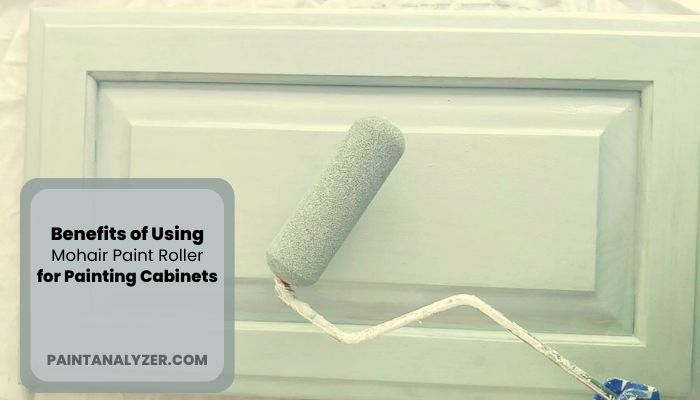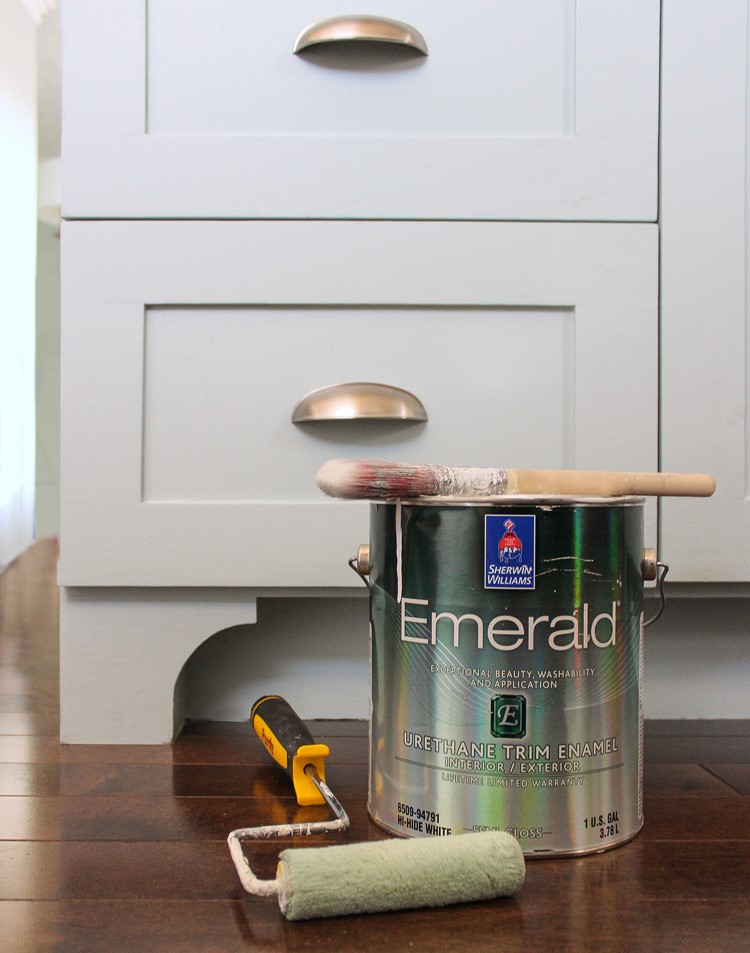Painting cabinets is a big job, but it’s one that can be made a lot easier with the right tools. One of the best tools for the job is a mohair paint roller.
Mohair paint rollers are made of natural fibers that are extremely absorbent, so that they can hold a lot of paint. This means that you can paint your cabinets in fewer coats, which will save you time. In addition, mohair paint rollers are very smooth so they won’t leave any brush strokes behind. This will give your cabinets a professional-looking finish.
In this article, we’ll discuss the benefits of using a mohair roller for cabinets. We’ll also provide tips on getting the best results and more.

Why Is Mohair Paint Roller Best For Painting Cabinets?
Mohair paint rollers are often considered the best type of roller for painting cabinets. There are a few reasons for this.
Mohair Rollers Creates A Smooth Painting Coat
A smoother finish is one of the most important things to look for in a paint roller. This is especially important when painting cabinets, as any imperfections will be very noticeable. Mohair rollers create a smooth finish that will look great once the paint is dry.
Less Likely To Leave Streaks Or Brush Marks
Another important consideration is the risk of streaks or brush marks. Mohair rollers are less likely to leave these behind, giving you a clean finish that you can be proud of.
Durable And Long-Lasting
When you invest in a paint roller, you want it to last. Mohair rollers are durable, meaning they stand up to repeated use. This makes them a great choice for painting cabinets, as you can use them over and over again without having to worry about them wearing out.
Environmental Friendly
Mohair is a natural fiber, making it more environmentally friendly than synthetic paint rollers. If you want to be more sustainable, then choosing a mohair roller is a great option.
Very Absorbing
Mohair is a very absorbent material, soaking up more paint than a synthetic roller. This is great news if you want full coverage with your paint job.
Easy Cleaning
Cleaning a mohair roller is very easy. All you need to do is rinse it in water and then let it air dry. This is much easier than cleaning a synthetic roller, which can be difficult to completely clean.
What Kind of Roller Should You Use to Paint Kitchen Cabinets?
You’ve decided to paint your kitchen cabinets and want to know what type of roller is best. Here’s a quick guide to help you choose the right one! The most important factor in choosing a roller is the material.
There are three main types of materials used for rollers: natural fibers, synthetic fibers, and foam.
Natural fiber rollers are made from materials like sheepskin, mohair, or wool. They’re absorbent and hold a lot of paint, making them ideal for use on large surfaces like walls and ceilings.
However, they can leave behind lint or shed fibers, so cleaning them after each use is important.
Synthetic fiber rollers are made from materials like polyester or nylon. They’re less likely to shed than natural fiber rollers and don’t absorb as much paint, so you won’t have to worry about drips or smears.
However, they can be more difficult to control when painting detailed areas like trim work or cabinets.
Foam rollers are made from foam. They’re lightweight and easy to maneuver, making them great for small spaces or tight corners. And because they don’t absorb paint like other types of rollers, there’s less risk of drips or smears. However, foam rollers tend to leave behind more visible brush strokes, so keep that in mind when selecting this roller type.
So, what type of roller is best for painting kitchen cabinets? It really depends on your personal preference and budget. If you’re looking for a cheap and easy option, go with a foam roller.
If you want a professional-looking finish without any streaks or brush marks, invest in a natural fiber roller (Mohair Paint Roller).
A Small Overview Of Mohair Paint Brush
A mohair paintbrush is a type of natural bristle paintbrush. The word “mohair” comes from the Arabic word for goat hair. Goat hair has been used to make brushes for centuries and is still considered one of the best materials for making high-quality paintbrushes.
Mohair paint brushes are made with soft bristles. Soft-bristled mohair brushes are typically used for painting surfaces that require a smooth finish, such as walls and ceilings.
These paint brushes come in various sizes, from small detailing to large flat brushes. The brush size you’ll need will depend on the project you’re working on. Smaller projects will require smaller brushes, while larger projects will need larger ones.
When choosing a mohair brush, it’s important to select one with high-quality bristles. Cheap bristles can easily fall out and leave unwanted streaks or brush marks. Also, be sure to look for a comfortable brush to hold and use; otherwise, you may get frustrated with your painting project instead of enjoying it!

Credit: thecraftpatchblog
How To Prevent Roller Marks When Painting Cabinets?
Are you considering painting your cabinets but dreading the thought of dealing with unsightly roller marks? If so, you’re not alone. Luckily, you can take a few simple steps to prevent this problem.
Step 1: Use A High-Quality Roller
Cheap rollers will likely leave behind lint and other debris, which will then become embedded in your paint job. Not only will this result in an uneven finish, but it will also make it more difficult to touch up any imperfections.
Step 2: Invest In A Good Primer
This will help to create a smooth surface for your paint to adhere to. Without a primer, you’re more likely to see roller marks, especially if your cabinets are made of a porous material like wood.
Step 3: Use A Light Touch
When it comes to painting, it’s always best to err on the side of caution. Apply your paint in thin, even coats, and be careful not to overload your roller.
Step 4: Let It Dry
Let each coat dry completely before applying the next. If you try to hurry the process, you risk leaving behind streaks and smudges.
Make sure to give each coat of paint ample time to dry before moving on to the next. Depending on the paint you’re using, this could take anywhere from a few hours to a full day. Rushing the process could result in a less than perfect finish, so it’s best to take your time.
Step 5: Sealing
Finish with a sealer. This will help to protect your paint job and make it more resistant to scratches, fading, and chipping. For best results, use a high-quality sealer designed for your specific type of paint.
Can Mohair Paint Rollers Also Be Used for Skirting Boards?
Yes, Mohair paint rollers can be used for skirting boards. However, the best paintbrush for skirting boards is still a high-quality angled brush. The brush offers more precision and control when painting the edges and corners of the skirting boards, resulting in a cleaner finish.
Can TSP Cleaner Enhance the Benefits of Using Mohair Paint Roller for Painting Cabinets?
When painting cabinets, using a Mohair paint roller can provide a smooth and even finish. By prepping the surface with a tsp cleaner for cabinets, you can enhance the adhesion of the paint and ensure a long-lasting result. The cleaner helps remove grease and grime, allowing the paint to bond effectively.
Can a Mohair Paint Roller Be Used for Painting Other Surfaces Besides Cabinets?
Yes, a Mohair paint roller can be used for painting other surfaces besides cabinets. Mohair rollers are versatile and can be used on various surfaces such as walls, ceilings, and furniture. The hot dog paint roller complete set is a great option for all your painting needs, providing smooth and even coverage.
Tips For Preparing Mohair Paint Roller Cover
Conclusion
In conclusion, if you’re looking for a paint roller that will give your cabinets a smooth, even finish, consider using a mohair paint roller. Mohair rollers are made from the hair of angora goats, and they’re known for their ability to lay down a thin, even layer of paint. Thanks for reading. Feel free to leave your appreciation or advice in the comments down below.
